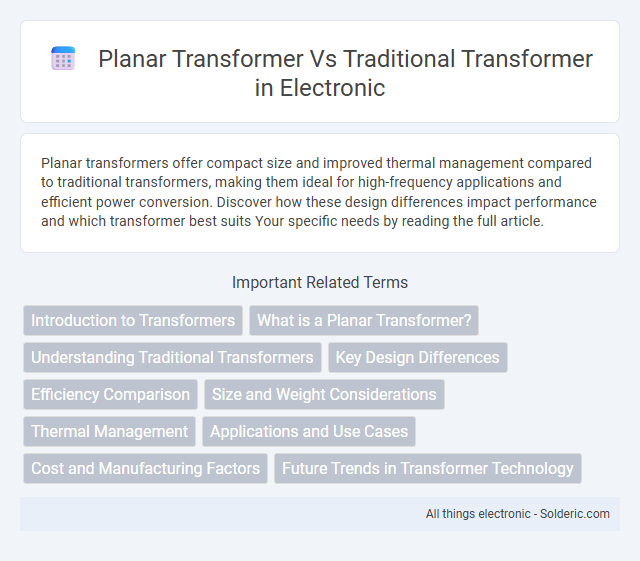Planar transformers offer compact size and improved thermal management compared to traditional transformers, making them ideal for high-frequency applications and efficient power conversion. Discover how these design differences impact performance and which transformer best suits Your specific needs by reading the full article.
Comparison Table
| Feature | Planar Transformer | Traditional Transformer |
|---|---|---|
| Architecture | 2D planar arrangement with layered attention | Sequential token-wise self-attention |
| Computational Complexity | Reduced, optimized for parallel processing | High, quadratic with input length |
| Scalability | Better scalability on large inputs | Challenged by very long sequences |
| Parameter Efficiency | Fewer parameters due to planar structure | More parameters, dense attention layers |
| Performance | Strong in spatial and vision tasks | Effective for NLP and sequence modeling |
| Use Cases | Image processing, spatial data analysis | Natural language processing, audio, time series |
Introduction to Transformers
Transformers are essential components in electrical systems, used to transfer electrical energy between circuits through electromagnetic induction. Planar transformers differ from traditional transformers by using flat, etched copper windings on a flat substrate, resulting in reduced size, improved thermal performance, and higher frequency operation. Your choice between planar and traditional transformers depends on application requirements such as power density, efficiency, and space constraints.
What is a Planar Transformer?
A planar transformer is a type of transformer that uses flat, layered windings printed on a PCB or metal substrate instead of traditional wire coils, resulting in a compact, low-profile design. This technology offers improved thermal management, higher efficiency, and better electromagnetic compatibility compared to traditional transformers. Your choice of a planar transformer can enhance power density and reliability in advanced electronic applications.
Understanding Traditional Transformers
Traditional transformers consist of wound copper wire coils around laminated iron cores, which efficiently transfer electrical energy through electromagnetic induction. Their bulky, heavy design and susceptibility to core losses limit applications requiring compactness and higher frequency operations. These transformers excel in low-frequency power distribution but face challenges in miniaturization and thermal management.
Key Design Differences
Planar transformers integrate windings in a flat, layered structure using printed circuit board (PCB) technology, significantly reducing size and improving thermal management compared to traditional transformers with wire-wound coils around a magnetic core. The planar design enables precise control over winding geometry, resulting in lower parasitic inductance and capacitance, which enhances high-frequency performance and efficiency. Traditional transformers rely on bulky, three-dimensional wire coils that often limit frequency response and increase electromagnetic interference in compact electronic applications.
Efficiency Comparison
Planar transformers offer superior efficiency compared to traditional transformers due to reduced eddy current and proximity losses from their flat windings and shorter magnetic paths. Their compact design minimizes leakage inductance and improves heat dissipation, enhancing overall performance in high-frequency applications. Traditional transformers typically exhibit higher core losses and bulkier form factors, limiting efficiency in power-dense environments.
Size and Weight Considerations
Planar transformers offer a significant reduction in size and weight compared to traditional transformers due to their flat, layered construction which allows for more compact winding arrangements. The use of printed circuit board (PCB) technology in planar transformers results in a thinner profile and lighter components, enhancing their suitability for space-constrained applications. These features make planar transformers ideal for modern electronics where minimizing footprint and weight are critical design factors.
Thermal Management
Planar transformers offer superior thermal management compared to traditional transformers due to their low-profile design and larger surface area, which enhances heat dissipation. The use of thin copper windings in planar transformers reduces winding resistance and heat generation, enabling higher power density and improved reliability. Traditional transformers typically rely on bulkier wire windings that produce more localized heat, requiring additional cooling methods to maintain safe operating temperatures.
Applications and Use Cases
Planar transformers are widely used in high-frequency applications such as power supplies for telecommunications, electric vehicles, and compact consumer electronics due to their low profile and improved thermal performance. Traditional transformers remain preferred for high-power, low-frequency applications like industrial power distribution and audio systems, where robustness and tolerance to high voltage are critical. The choice between planar and traditional transformers depends on factors like space constraints, efficiency requirements, and operating frequency ranges.
Cost and Manufacturing Factors
Planar transformers offer cost advantages in high-volume production due to automated PCB manufacturing processes, reducing labor and material costs compared to traditional wire-wound transformers that require manual winding. Their compact design and better thermal management minimize the need for additional cooling components, further lowering manufacturing expenses. Your choice between the two should consider the scale of production and the precision required, as planar transformers provide consistent quality but may have higher initial setup costs.
Future Trends in Transformer Technology
Planar transformers offer enhanced thermal management, compact design, and high-frequency performance compared to traditional transformers, driving their adoption in next-generation power electronics. Emerging trends emphasize integrating planar transformers with wide bandgap semiconductors like GaN and SiC to boost efficiency and reduce system size. Your choice of transformer technology will increasingly benefit from advancements in planar designs tailored for electric vehicles, renewable energy systems, and fast-charging applications.
planar transformer vs traditional transformer Infographic

 solderic.com
solderic.com